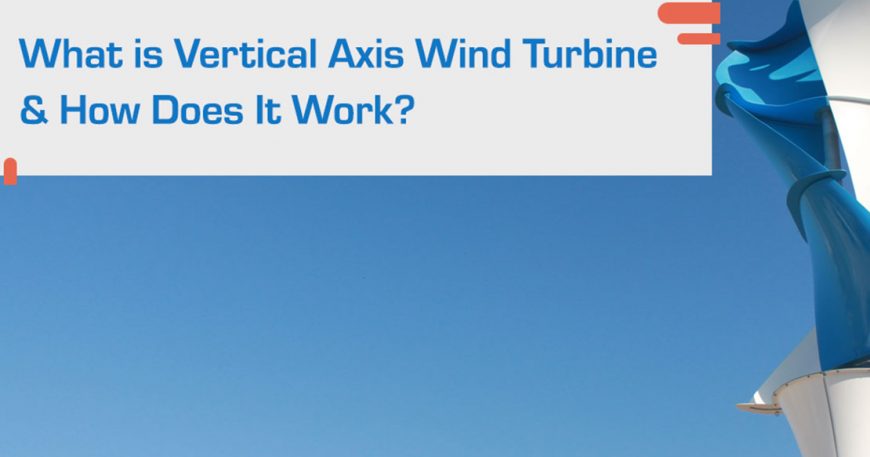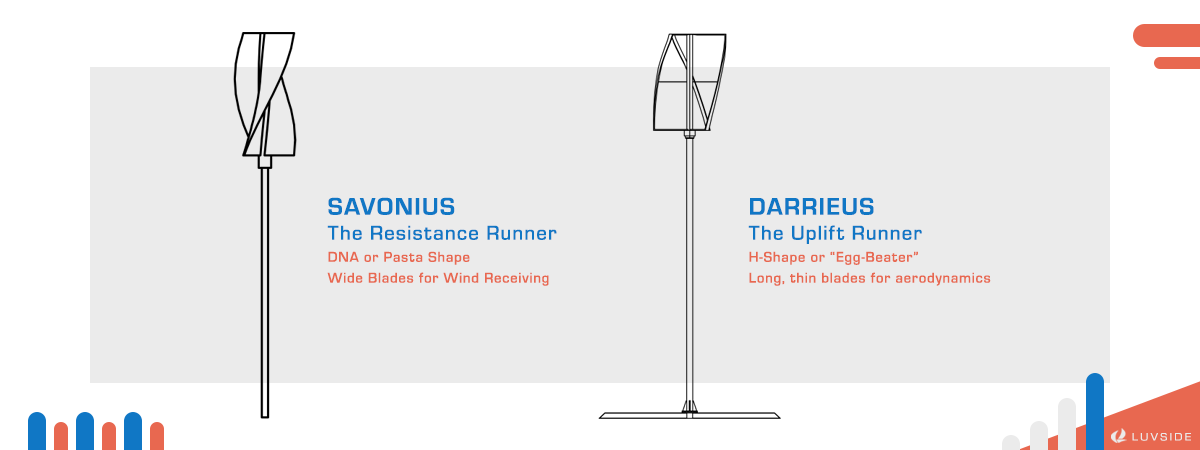
How do vertical axis wind turbines work?
Vertical axis wind turbines are wind turbines whose rotors rotate around a vertical shaft with vertically oriented blades. They produce electricity by utilizing wind power the same way horizontal axis wind turbines do: Wind drives the rotor to turn, the rotation connects to the generator, and the generator converts the mechanical energy into electricity.
Vertical axis wind turbines are the oldest form of wind turbines
Now viewed as a product for a niche market, vertical axis wind turbines are in fact the earliest recorded wind turbines. The use of such mechanical models dates as far back as the Persian times in the 7th century for milling and pumping. In 1887, Scottish electrical engineer and academic, James Blyth, built one of the first recorded electricity-generating wind turbines, also using the vertical axis structure.
Two distinctive designs, two working principles
What’s special about vertical axis wind turbines is the variety of possible designs— blades, structures, shapes— which then determines the operational principle, performance, and applications. Vertical axis wind turbines come in many shapes, but technically, they can be categorized in to two groups based on their operational principles:

Savonius Wind Turbines: The Resistance Runner
Savonius wind turbines have blades built around the vertical shaft in a helix form, which basically looks like DNA or fusilli pasta. Wide, solid wind-receiving area of the blades is one of the most significant features of a Savonius wind turbine.
When in operation, Savonius wind turbines rely on the flow resistance mechanism to turn their rotors. In simple words, the dynamic pressure of the wind against the blades pushes the rotor into rotation. At the same time, the opposite side of the blades encounters a force of aerodynamic resistance or “drag.” This is just like what we experience when cycling or running: There’s always the air flow coming against us. Because of this, Savonius wind turbines can only turn as fast as the wind speed.
Darrieus: The Uplift Runner
Often called the “egg-beater” and named after the French inventor Georges Darrieus, classic Darrieus turbines have long, curved wings with each end attached to the top and bottom of the rotor shaft. Another model of the Darrieus turbines has three straight wings connected to the shaft parallelly, forming the “H” shape.
In terms of operation, Darrieus utilizes the “lift” aerodynamic force to rotate. By flowing around the structure, the wind creates a suction on the front side of the turbine, driving the wings to rotate. Because of the shape of the wings, they do not experience as much drag as Savonius turbines do. Once the rotation starts, Darrieus wind turbines are able to accelerate to rotate faster than the wind speed.
How vertical axis wind turbines differ from horizontal axis wind turbines
Due to certain structural characteristics, vertical axis wind turbines are typically smaller than horizontal axis wind turbines. This adds to the number of advantages such as low noise emission and high turbulence endurance that make them perfect for electricity generation in populated or urban areas as well as in unstable, gusty wind.
Since vertical axis wind turbines have less energy efficiency and power output, it is common to group multiple turbines into a wind power plant or use them as one of many electricity sources of a building or campus. It is possible to connect a vertical axis wind turbine into the local power grid or with an external storage battery. Although not as common as horizontal axis wind turbines, vertical axis wind turbines are also used on offshore platforms to support various industrial activities.
In the past, the wind power industry has always been focused on the development and construction of horizontal axis wind turbines because they are the most powerful wind turbine models. Vertical axis wind turbines remain relatively underdeveloped and even a bit experimental.
Horizontal vs. Vertical: It is not a competition
When you compare a vertical axis wind turbine with a horizontal axis wind turbine, the answer is clear: Vertical axis wind turbines cannot compete with horizontal axis wind turbines, particularly regarding power output and efficiency. The question is, why should they be comparable or competitive against each other?
As a company dedicated to the development of vertical axis wind turbines, we believe these two types of turbines are to co-exist in the wind power industry because they are designed for completely different applications. There are situations where horizontal axis wind turbines thrive excellently, and also areas where they are not suitable or prohibited due to their installation requirement or environmental impacts.
Vertical axis wind turbines, on the other hand, are more geographically flexible and not restricted as much by governmental policies. This makes them great alternatives for conditions unsuitable for horizontal axis models.
For LuvSide, as wind power supporters and sustainability advocates, it is more important to utilize all possible solutions than to create competition when the expansion of renewable energy is an increasing need for our society. That is why we and many engineers around the world devote our resources and knowledge into research, development, and innovation of vertical axis wind turbines.